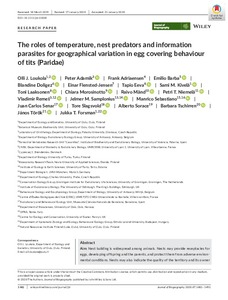The roles of temperature, nest predators and information parasites for geographical variation in egg covering behaviour of tits (Paridae)
Olli J. Loukola; Alberto Sorace; Jukka T. Forsman; Vladimir Remeš; Petri T. Niemelä; Peter Adamik; Raivo Mänd; Toni Laaksonen; Blandine Doligez; Emilio Barba; Chiara Morosinotto; Barbara Tschirren; Tore Slagsvold; Jelmer M. Samplonius; János Török; Sami M. Kivelä; Manrico Sebastiano; Einar Flensted‐Jensen; Juan Carlos Senar; Frank Adriaensen; Tapio Eeva
The roles of temperature, nest predators and information parasites for geographical variation in egg covering behaviour of tits (Paridae)
Olli J. Loukola
Alberto Sorace
Jukka T. Forsman
Vladimir Remeš
Petri T. Niemelä
Peter Adamik
Raivo Mänd
Toni Laaksonen
Blandine Doligez
Emilio Barba
Chiara Morosinotto
Barbara Tschirren
Tore Slagsvold
Jelmer M. Samplonius
János Török
Sami M. Kivelä
Manrico Sebastiano
Einar Flensted‐Jensen
Juan Carlos Senar
Frank Adriaensen
Tapio Eeva
WILEY
Julkaisun pysyvä osoite on:
https://urn.fi/URN:NBN:fi-fe2021042822063
https://urn.fi/URN:NBN:fi-fe2021042822063
Tiivistelmä
Aim Nest building is widespread among animals. Nests may provide receptacles for eggs, developing offspring and the parents, and protect them from adverse environmental conditions. Nests may also indicate the quality of the territory and its owner and can be considered as an extended phenotype of its builder(s). Nests may, thus, function as a sexual and social signal. Here, we examined ecological and abiotic factors-temperature, nest predation and interspecific information utilization-shaping geographical variation in a specific nest structure-hair and feather cover of eggs-and its function as an extended phenotype before incubation in great (Parus major) and blue tits (Cyanistes caeruleus) across Europe. We also tested whether egg covering is associated with reproductive success of great tits. Location Fourteen different study sites and 28 populations across Europe. Taxon Parus major, Cyanistes caeruleus. Methods We recorded clutch coverage estimates and collected egg covering nest material from the tit nests. We also measured nest specific breeding parameters and phenotypic measurements on adults. We tested whether mean spring temperatures, nest predation rates and flycatcher (Ficedulaspp) densities in the study areas explain the large-scale geographical variation of clutch coverage and reproductive success of tits. Results The degree of egg coverage of great tits increased with lower mean spring temperature, higher nest predation rate and higher flycatcher density. We did not find egg covering of blue tits to be associated with any of the ecological or abiotic factors. Moreover, egg covering of great tits was not associated with reproductive success in our cross-sectional data, yet a rigorous assessment of fitness effects would require long-term data. Main conclusions Our findings suggest that, in great tits, egg covering may simultaneously provide thermal insulation against cold temperatures during egg-laying in spring and also represent a counter-adaptation to reduce information parasitism by flycatchers and nest predation. Hence, geographical variation in interspecific interactions, and consequently in co-evolutionary processes, may affect the evolution of nest characteristics besides environmental conditions.
Kokoelmat
- Rinnakkaistallenteet [19204]
